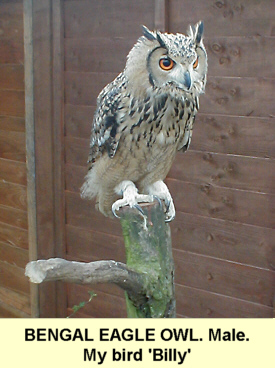Bubo bengalensis

BENGAL or
INDIAN EAGLE OWL.
Bubo bengalensis
IDENTIFICATION. The Bengal Eagle Owl is a smaller and lighter coloured cousin of the European Eagle Owl. Large orange eyes are set in the dark rimmed, buff coloured facial disc. Dark ear tufts rise up from the top of the head which is buff coloured with dark brown barring. An almost white chin leads to the sandy coloured body that is streaked with dark feathers. The bold streaking becomes finer toward the lower abdomen with faint barring radiating outwards on each feather. The feet are feathered to the talons in a light colour that can be matched to a bar running along the edge of the wing. The tops of the wings and the back of the owl are a buff colour with dark brown barring.
IN FLIGHT. The flight is similar to that of the European Eagle Owl. Slow wing beats and gliding close to the ground are its normal pattern, but fast bursts of speed are used in pursuit of nimble prey.
DISTRIBUTION. A bird of Northern and Central India, Pakistan, Nepal and Burma. Preferring wooded hillsides, areas of bushy scrub and semi dessert.
FOOD. Generally small mammals and medium sized birds. Also reptiles, amphibians and insects supplement the diet.
BREEDING. November-April. 2 to 4 eggs laid in a simple scrape on a rocky ledge or on the ground under cover. Young hatch after 5 weeks, flying 45-50 days later.
SIZE. 50-56 cm (19- 22in)
WEIGHT. 1100g-2000g (2lb 6oz-4lb 4oz)
CALL. Whooo.
FALCONRY.
The Bengal Eagle Owl has the reputation of being one of the nicest owls to fly. The temperament is generally friendly and the weight neither to light or to heavy to cause beginners any problems. Bengal's are not generally used as hunting birds (American Great Horned Owls being preferred) but this is not to say they will not catch. In the wild Bengal Eagle Owls will catch birds to the size of peafowl and I have heard reports of rabbit being taken in this country. If hunting is not what you are looking for then again the Bengal might be for you.
When it comes to training Eagle Owls (in fact most owls) the chicks are taken from the nest about three weeks after hatching for imprinting. This basically means you become mum and junior starts to think of himself as human. So from the day you pick up your bird until it is flying you will be chopping dead chicks, rats and mice for tea, cleaning up the unending pools of owls droppings (watch out for the brown ones!), finding out that owls have no attention span and generally devoting more time to him than to the TV!
Problems with Bengal's can be their loud hoot - so make sure that your neighbours are very understanding. Age must also be taken into consideration. The average lifespan appears to be about 25 to 30 years, with some owls carrying on passed that! It is always best to be aware that however much you trust your owl, it is still an animal and could therefore be unpredictable if poorly treated, coming into the breeding season or if it is just having a bad day.
Falconry marks
![]()
![]()
![]()
![]()